Beyond Ethereum: Exploring the Potential of Emerging Blockchains for Stablecoin Adoption
Original author: Aquarius
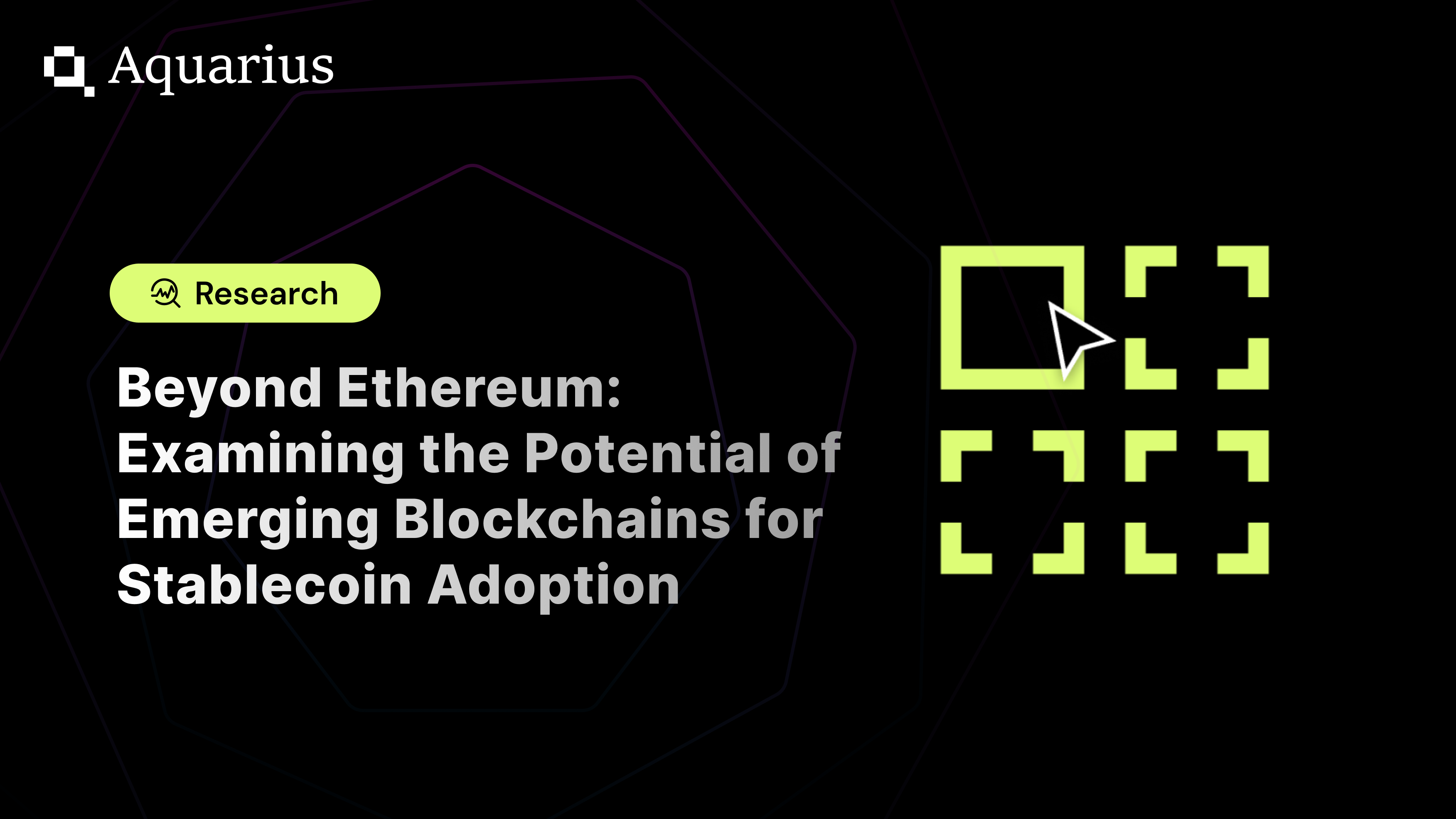
background
The stablecoin market has grown rapidly and has become an important force in the digital economy, even competing with traditional financial networks. According to Coinbase research, the total transaction volume of stablecoins in 2023 will exceed 10.8 trillion US dollars. After excluding "unnatural" transactions (such as robot-driven or automated transactions), the actual transaction volume is about 2.3 trillion US dollars. This adjusted data reflects an organic annual growth rate of 17% for stablecoins, highlighting the increasingly important role of stablecoins in retail and institutional finance. The following chart provides a visual insight into the current landscape and growth trajectory of stablecoins in major blockchain ecosystems.
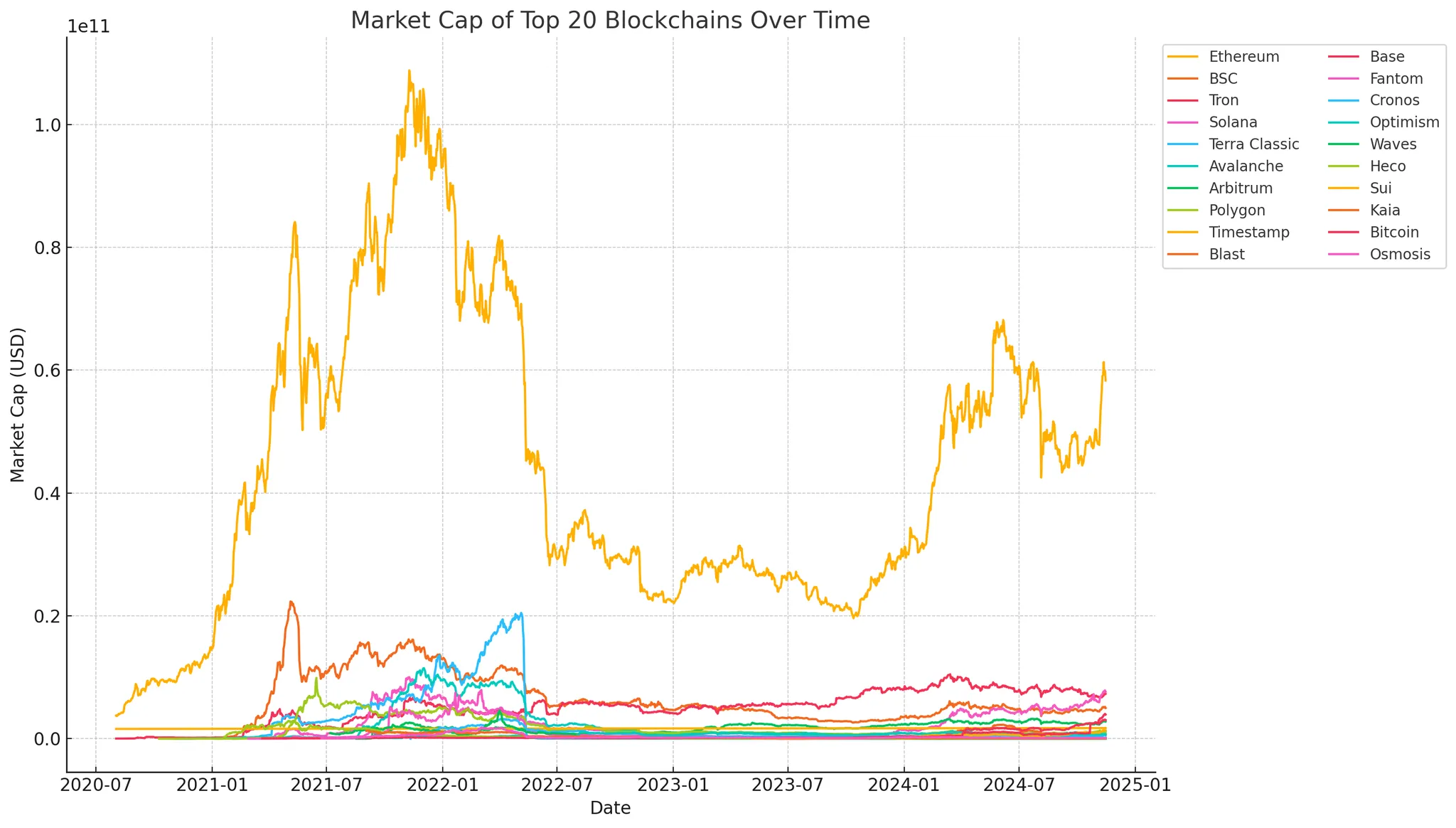
This chart shows the overall market capitalization trend of the top 20 blockchains from 2020 to 2025. Ethereum has performed particularly well, with a market capitalization of more than $100 billion at its peak, dominating the entire blockchain ecosystem. Such a high market capitalization is closely related to Ethereum's role as the main platform for DeFi and stablecoin issuance, which allows it to maintain a strong position even in market fluctuations. Other blockchains such as BSC, Tron, and Solana have relatively low market capitalizations but stable performance. Tron and BSC, in particular, have shown a steady growth trend, highlighting their role as alternative platforms for stablecoins and DeFi, especially in regions and application scenarios where transaction costs and speed are critical.
It is worth noting that emerging platforms such as Arbitrum, Sui, and Optimism have gradually grown in market capitalization, indicating increasing adoption. This growth trajectory suggests that as these ecosystems continue to mature, they may challenge existing leaders in the future by meeting specific needs or providing competitive transaction efficiency. The data shows that despite Ethereum's dominance in overall market capitalization, other blockchains are still attracting users and developers, indicating a potential shift in stablecoin activity as the ecosystem matures.
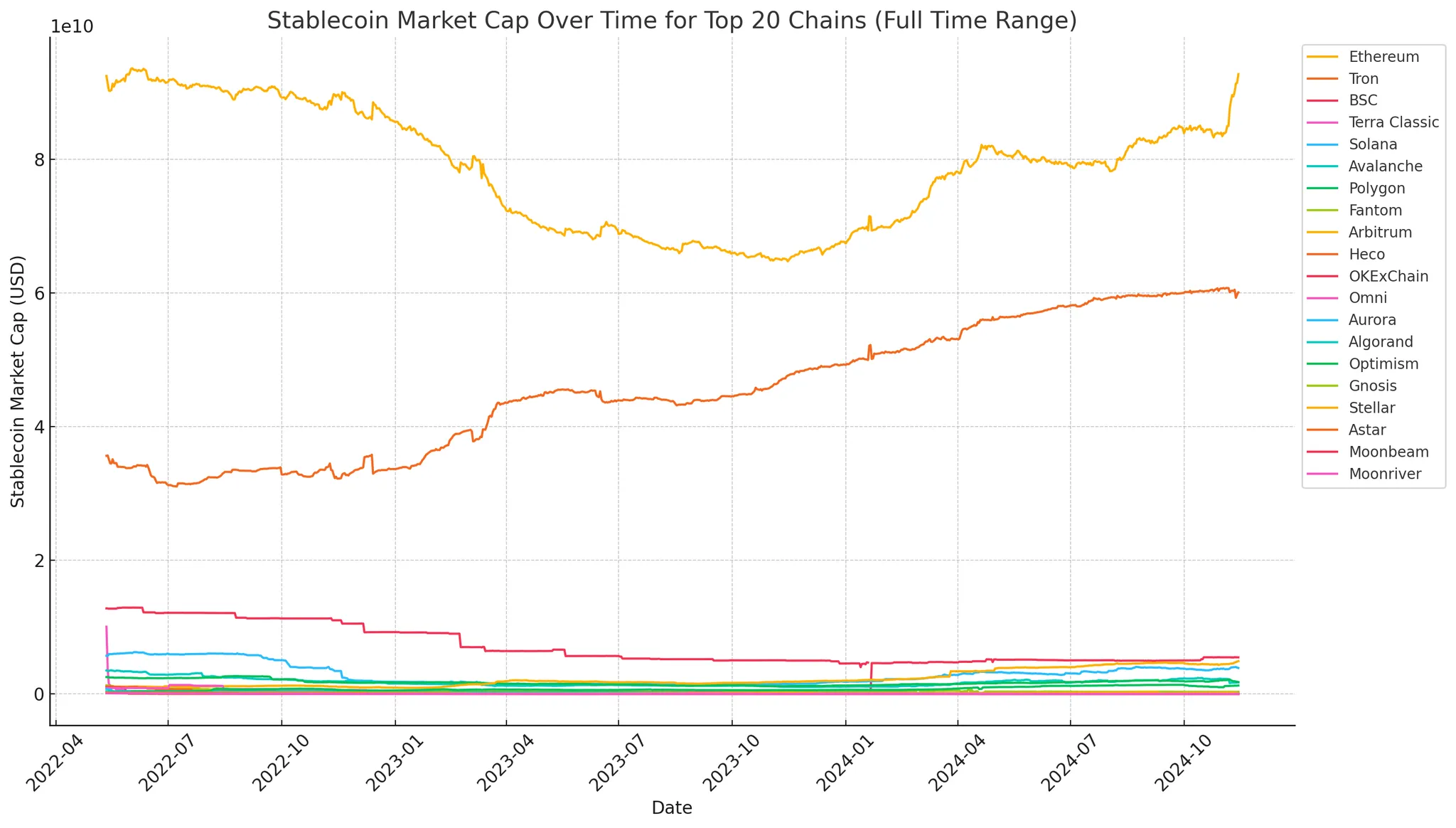
This chart shows the stablecoin market cap trends for the top 20 blockchains in more detail. Ethereum leads the way with over $8 billion in stablecoin market cap, reflecting its important role as a custodian for major stablecoins such as USDT, USDC, and DAI. Ethereum's massive market cap supports its position as a stablecoin hub, with demand coming primarily from DeFi applications and institutional users seeking compliant stablecoins. However, Tron stands out as a major competitor with a stablecoin market cap of around $4 billion. Tron's appeal lies in its low transaction fees and fast processing speeds, which make it particularly popular in high-frequency trading scenarios, such as remittances and cross-border payments.
Other chains, such as BSC, Terra Classic, and Solana, have relatively small stablecoin market caps but play a key role in the diverse stablecoin ecosystem. For example, BSC’s stablecoin market cap is around $2 billion, attracting DeFi projects and retail users seeking lower fees than Ethereum. Smaller blockchains, such as Algorand and Stellar, are positioned as niche platforms for stablecoins, often targeting specific use cases such as cross-border payments and small transactions.
Ethereum: A solid leader
Ethereum, often viewed as the cornerstone of decentralized finance (DeFi), remains the dominant chain for stablecoin activity, with a stablecoin market cap of over $8 billion. Several factors have enabled Ethereum to maintain its leadership in the stablecoin ecosystem:
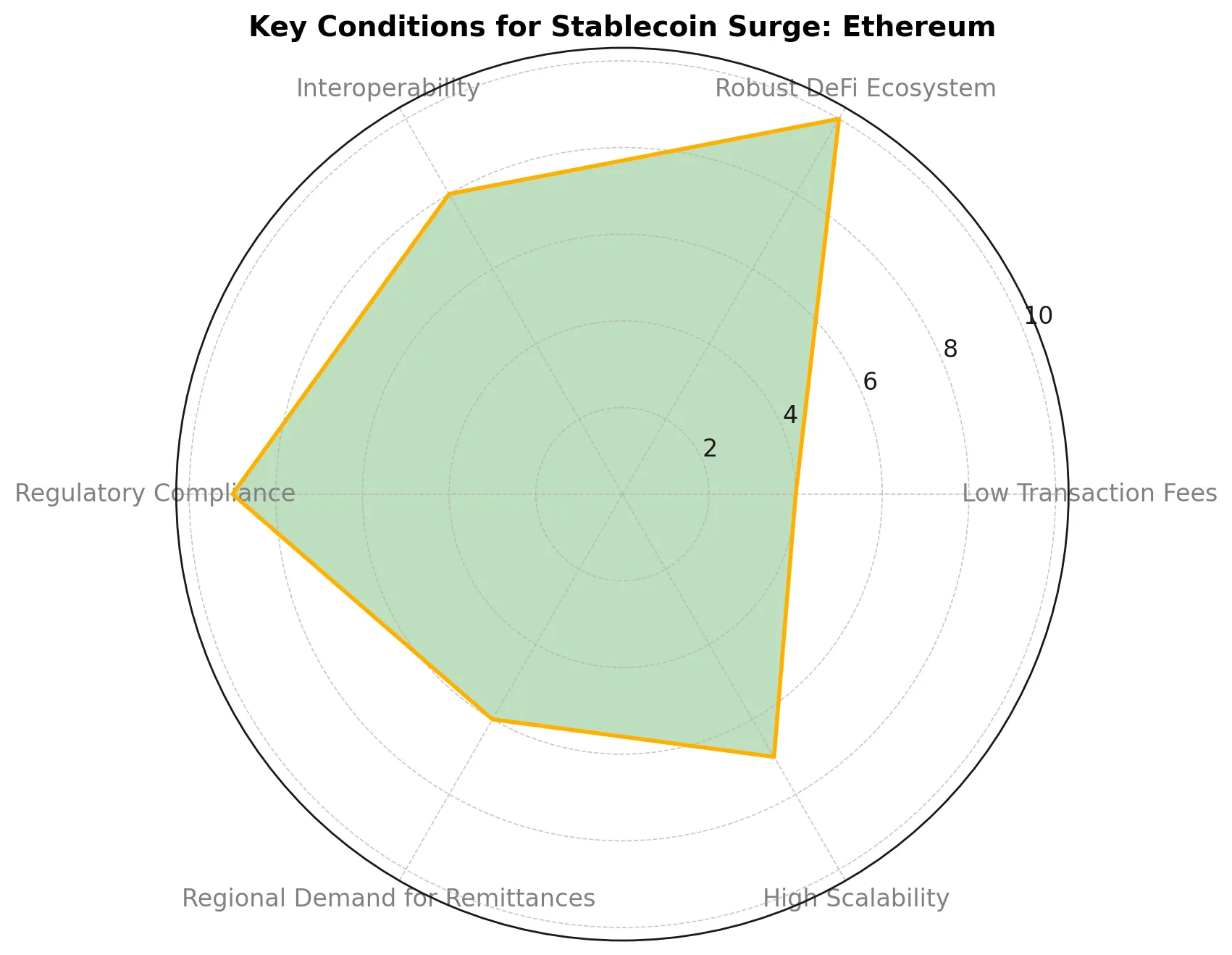
Mature and interconnected DeFi ecosystem: Ethereum’s large and mature DeFi ecosystem includes well-known protocols such as Uniswap, Compound, and Aave, which are highly dependent on stablecoin liquidity in their operations. Stablecoins are essential for liquidity pools, lending, and yield farming, making Ethereum an indispensable platform for users seeking comprehensive DeFi services.
Institutional and Regulatory Trust: Stablecoins on Ethereum, especially USDC and DAI, have gained regulatory recognition and institutional trust. As more institutions enter the crypto space, Ethereum’s reputation as a secure and decentralized network makes it an ideal choice for compliant, institutional-grade stablecoins. Circle’s USDC and MakerDAO’s DAI are the main stablecoins native to Ethereum, serving as pillars of trust in the ecosystem.
Diverse stablecoins and use cases: Ethereum hosts a wide range of stablecoins, including fiat-backed stablecoins such as USDT and USDC, as well as algorithmic and decentralized stablecoins such as DAI. This diversity enables Ethereum users to choose the stablecoin that best suits their risk tolerance, regulatory needs, and preferences. For example, DAI is uniquely attractive because it is not directly pegged to fiat reserves, which is consistent with the decentralized values advocated by the Ethereum community.
Second-layer solutions address scalability issues: Ethereum faces scalability challenges, and high gas fees limit small users from participating in DeFi. However, second-layer solutions such as Arbitrum, Optimism, and zk-Rollups are significantly reducing transaction costs and increasing throughput, allowing Ethereum to continue to maintain its leadership in stablecoin use cases without sacrificing decentralization.
As Ethereum continues to develop its second-layer ecosystem and fully transition to Ethereum 2.0, its dominance in the stablecoin market is expected to continue. As the regulation around stablecoins becomes clearer, institutional adoption will grow further, which may lead to more fiat-backed and compliant stablecoins being launched on Ethereum. In addition, Ethereum's DeFi ecosystem may also continue to innovate and develop new stablecoin use cases, including synthetic assets, cross-chain stablecoins, and more complex yield-generating products.
Solana: A high-performance Ethereum alternative
Solana is often seen as a high-performance alternative to Ethereum, known for its fast transaction speeds and low fees. Although Solana's stablecoin market capitalization is significantly smaller than Ethereum's, it has successfully attracted a loyal user base and is growing in popularity among retail users and developers looking for low-cost solutions.
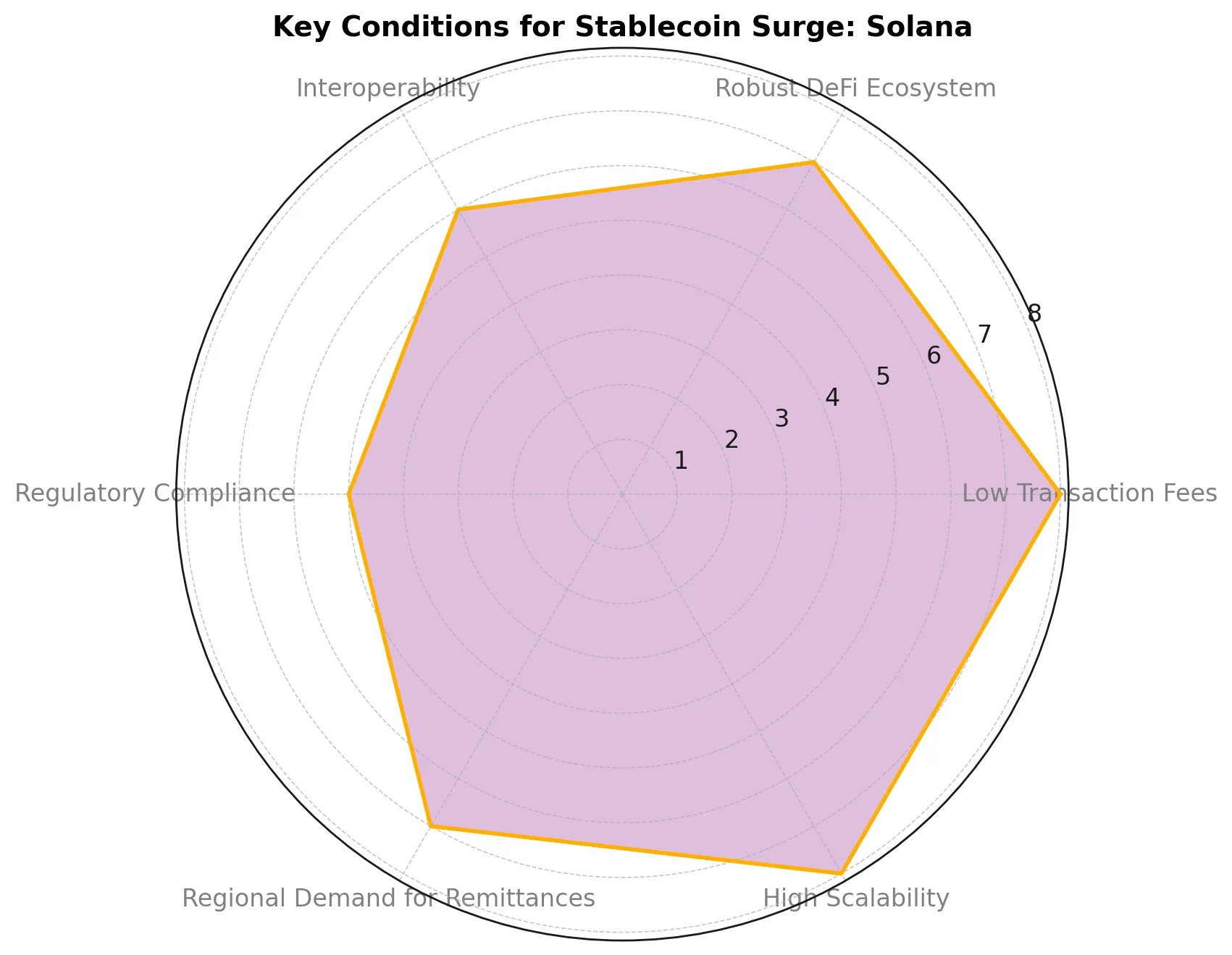
High-speed, low-cost transactions: Solana's unique Proof of History (PoH) consensus mechanism supports high throughput and low latency, enabling the network to process thousands of transactions per second with extremely low fees. This makes Solana an ideal choice for applications that require frequent transactions, such as micropayments and retail stablecoin transfers. As a result, stablecoins like USDC and USDT are often used on Solana for daily payments and fast transfers within the ecosystem.
Integration of payments and gaming applications: Solana is positioned as an ideal platform for industries such as gaming and payments, which require fast and cheap transactions. Its user-friendly development tools and support for high-performance applications make it a preferred platform for developers to build decentralized applications (dApps), which are often integrated with stablecoins. For example, blockchain game Star Atlas and music streaming service Audius are taking advantage of Solana's speed and stability to use stablecoins as in-game currency and reward tools, respectively.
Network stability issues: While Solana’s high performance is a major advantage, it also faces network outages and stability issues. These downtimes have caused some users to question its reliability, especially in high-value transactions or institutional use cases. Solana’s network resilience is still developing, and it needs to solve these technical challenges to gain full trust in the stablecoin and DeFi markets.
Collaboration with USDC and cross-chain solutions: Solana’s collaboration with Circle, the issuer of USDC, is a key factor in driving the adoption of stablecoins on the platform. The availability of USDC on Solana provides users with a trusted dollar-backed stablecoin, enhancing Solana’s appeal. In addition, Solana is exploring cross-chain solutions that will allow assets to flow seamlessly between Solana and Ethereum, providing users with more flexibility and expanding its influence in the stablecoin market.
Solana has significant growth potential in the stablecoin space, especially if it can maintain network stability and further solidify its position in gaming and retail payments. Through continued collaboration with USDC and exploring cross-chain capabilities, Solana is expected to attract more stablecoin transactions and DeFi applications. However, its centralized validator structure and network outage issues may limit its appeal to institutions unless these issues are resolved.
Key conditions for stablecoin growth
As stablecoins continue to gain traction in the cryptocurrency and financial markets, certain ecosystem characteristics and environments are more conducive to the adoption and growth of stablecoins. These environments are not only technologically advantageous, but also strategically able to meet the needs of retail users and institutional investors. Below are the specific characteristics of the blockchain ecosystems most likely to experience a stablecoin boom, as well as the latest data and trends observed in the market.
1. Low transaction fees
Stablecoin transactions are often frequent and require low latency, especially in scenarios where users rely on stablecoins for daily transactions, cross-border payments, and remittances. Ecosystems with low transaction fees and high scalability are more attractive because they enable cost-effective transactions without network congestion.
In a 2023 survey of stablecoin users, more than 60% of respondents said that transaction costs were the main factor in their choice of blockchain platform. Ethereum's average transaction fee often exceeds $10 during network congestion, while networks such as Tron and BSC have an average transaction fee of less than $0.10. This has attracted a large number of USDT to migrate from Ethereum to Tron, which has captured about 30% of the USDT supply, mainly due to its low fees, which is particularly attractive in areas with high cross-border remittance demand. In addition, Binance Smart Chain (BSC) continues to attract retail users to participate in its DeFi ecosystem due to its much lower transaction fees than Ethereum.
Blockchain environments that offer low fees and high scalability, such as Polygon’s Ethereum Layer 2 solution and Solana, are also well suited for stablecoin growth. Solana can process up to 65,000 transactions per second with low average fees, especially in payment and gaming applications, where stablecoin adoption is gradually increasing.
2. A strong DeFi ecosystem with diverse use cases
A strong DeFi ecosystem not only attracts stablecoin liquidity, but also provides utility beyond simple transactions. In an environment with applications such as lending and yield generation, stablecoins serve as a stable medium of exchange and collateral, becoming the core of various DeFi products.
Ethereum hosts over 70% of DeFi applications worldwide, and stablecoins account for nearly 50% of the total locked value (TVL) of Ethereum DeFi protocols. This widespread use of stablecoins is the core reason why Ethereum remains ahead in stablecoin adoption, despite its higher fees. As of the second quarter of 2024, Ethereum's DeFi locked value is about $40 billion, of which stablecoins (such as USDC, USDT, and DAI) account for a significant part.
Binance Smart Chain (BSC) also has an active DeFi ecosystem, with platforms such as PancakeSwap and Venus widely using stablecoins as the basis for liquidity pools and lending markets. In 2023, BSC's DeFi lock-in volume exceeded $5 billion, of which stablecoins accounted for about 40% of the liquidity pool. This practicality and ecosystem accessibility further encourages the adoption of stablecoins.
3. Interoperability
As the crypto space gradually moves towards a multi-chain ecosystem, interoperability has become an important factor in the adoption of stablecoins. Stablecoins need to circulate seamlessly between different blockchains to meet the needs of users to trade or hold assets across multiple chains. Ecosystems that can easily transfer stablecoins across chains will benefit from increased adoption.
According to a Chainalysis report in 2023, cross-chain stablecoin transfers account for about 25% of all stablecoin transactions. Solutions like Cosmos's Inter-Blockchain Communication Protocol (IBC) support the free circulation of stablecoins between different chains in the Cosmos ecosystem, promoting a wider range of liquidity and application scenarios.
Cosmos and Polkadot are two major ecosystems focused on interoperability. Cosmos’ IBC protocol allows blockchains within its network to interact seamlessly and stablecoins to be easily transferred between chains, promoting their adoption in specific ecosystems, such as Terra’s UST (before the crash) and other stable assets issued by Cosmos chains. Polkadot’s parachain structure provides similar interoperability, a feature that helps drive stablecoin adoption across DeFi and specialized applications. Projects such as USDC also prioritize multi-chain issuance, currently supporting Ethereum, Solana, BSC, and Avalanche. By achieving cross-chain compatibility, these ecosystems are able to increase the utility of stablecoins and promote broader adoption.
4. Support regulatory compliance and institutional needs
As regulatory scrutiny of stablecoins grows around the world, compliance has become a key factor in stablecoin adoption. Blockchain ecosystems that support compliance requirements, such as Know Your Customer (KYC) and Anti-Money Laundering (AML) regulations, are likely to gain stronger adoption among institutional users and compliant stablecoin issuers.
In 2023, about 30% of stablecoin inflows on Ethereum are related to institutional transactions, mainly due to the regulatory compliance capabilities of Ethereum stablecoins such as USDC. In contrast, chains with looser regulatory structures such as Tron mainly serve retail users and remittance-based use cases.
Algorand and Ethereum have positioned themselves as regulation-friendly ecosystems. Algorand supports compliant stablecoins such as USDC and has established partnerships with regulated financial institutions to ensure compliance. Ethereum, through Circle’s USDC and MakerDAO’s DAI, offers regulatory-compliant options, making it the preferred stablecoin issuance platform with significant institutional interest.
As regulation around stablecoins becomes clearer, blockchains that prioritize compliance may attract more institutional participation. For example, Avalanche’s customizable subnet feature allows institutions to build regulated environments, a feature that may attract stablecoin issuers that need to follow specific compliance standards.
5. Geographic and regional demand for low-cost remittances
In regions with limited financial inclusion or high banking fees, stablecoins offer a viable alternative for everyday transactions and cross-border remittances. Ecosystems that can meet the needs of these markets through low fees, high accessibility, and integration with payment providers have an advantage in stablecoin adoption.
According to the World Bank's 2023 report , global remittances have exceeded $700 billion, with stablecoins accounting for an increasing share of cross-border transactions in countries with limited financial infrastructure. Blockchain environments that provide low transaction fees and fast processing capabilities have the potential to capture this part of the remittance market.
Tron is popular in regions such as Asia, Africa, and Latin America, and its low fees make it ideal for cross-border remittances. Tron's network processes a large number of stablecoin transactions every day, especially USDT, which has been widely adopted in these regions as a tool for overseas remittances without traditional banking services. Tron's average transaction fee remains below $0.10, making it an ideal platform for stablecoin use based on remittances.
BSC (Binance Smart Chain) is also suitable for the remittance market due to its low fees and strong presence in Asia. In these regions, Binance's exchange ecosystem has established trust. In addition, chains like Celo are targeting emerging markets by focusing on mobile financial services to promote the use of stablecoins among unbanked or underserved populations.
6. High Scalability
Layer 2 solutions provide blockchains with an effective way to solve high transaction fees while maintaining security and decentralization. Blockchains that integrate Layer 2 scaling solutions can support larger stablecoin transaction volumes at lower costs, thereby attracting users who are excluded due to the high costs of Layer 1 networks.
Ethereum-based Layer 2 protocols such as Arbitrum and Optimism have a total locked value (TVL) of more than $5 billion by mid-2024. Among them, stablecoins account for a significant proportion of the use in various DeFi applications and payments. Layer 2 solutions reduce transaction costs by more than 90%, making them extremely attractive to stablecoin users.
Polygon is one of the leading Layer 2 scaling solutions, which has driven significant growth in stablecoins by providing the security of Ethereum with lower fees. Platforms like Aave and Uniswap have deployed on Polygon to take advantage of lower costs. Meanwhile, USDC and DAI have seen significant growth in usage on Polygon. Similarly, the cost-effectiveness of Arbitrum and Optimism has also attracted DeFi protocols that rely on stablecoins.
As more chains adopt Layer 2 scaling solutions, stablecoin adoption in these environments is likely to increase, allowing users to access stablecoin functionality at a lower cost.
Potential challengers
As the global demand for stablecoins grows, emerging blockchain ecosystems such as TON (The Open Network) and Sui show great potential for stablecoin adoption due to their unique infrastructure, target user base, and growth strategies. Although mature blockchains such as Ethereum, Tron, and BSC currently dominate stablecoin activities, TON and Sui are injecting differentiated competitiveness into the stablecoin market through innovative approaches. Below we provide a detailed analysis of TON and Sui's potential to drive stablecoin growth, compare them with current leaders, and explore the financial impact of the growth of stablecoin activities in these ecosystems.
TON: Relying on the Telegram network to promote retail-oriented stablecoin adoption
Originally developed by Telegram and later handed over to the open source community, TON has grown into a high-performance blockchain. TON's market cap is currently around $5 billion, which is relatively small compared to Ethereum's $200 billion and BSC's $35 billion. Nevertheless, TON's potential lies in its unique integration with Telegram. Telegram has more than 700 million monthly active users worldwide, and this ready-made user base makes TON a serious contender for stablecoin adoption, especially in markets where Telegram is widely used for communications and peer-to-peer transactions.
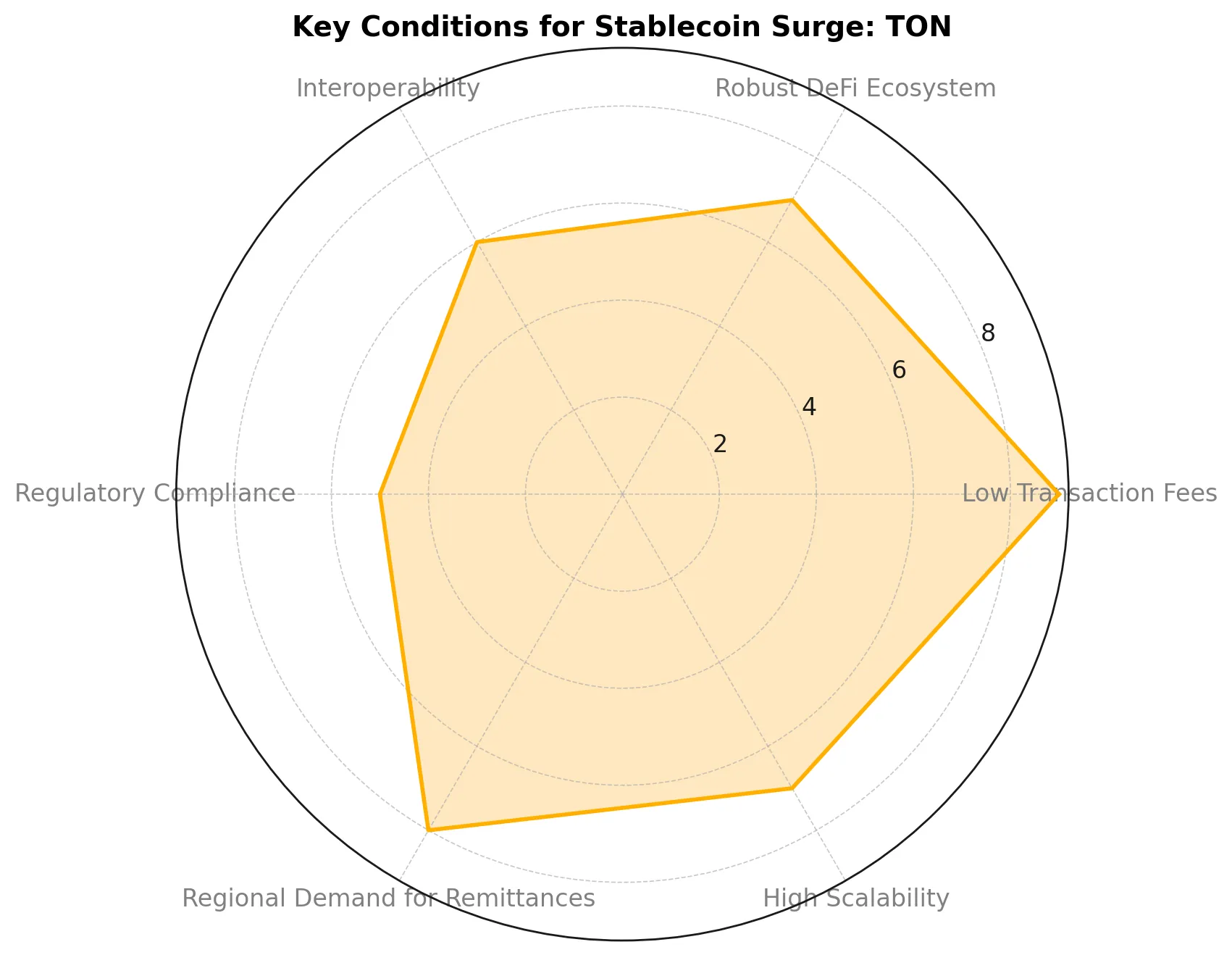
Key features driving stablecoin adoption
Seamless integration with Telegram: TON’s direct integration with Telegram makes stablecoins on its network highly accessible to Telegram users, enabling seamless peer-to-peer transfers and payments. This setup is particularly advantageous in countries with limited banking infrastructure but widespread Telegram use, such as Russia, Ukraine, Turkey, and parts of the Middle East and Southeast Asia.
Case use case: If stablecoins such as USDT or USDC are widely adopted on TON, users can send stablecoins with one click within the Telegram app. This integration could make stablecoins on TON as easy to use as Venmo or WeChat Pay, providing a low-threshold entry point for users who are not familiar with blockchain.
Low Fees and High Scalability: TON's sharding architecture enables it to handle high transaction volumes at low cost, making it attractive for stablecoin trading. TON's average transaction fee is estimated to be less than $0.01, comparable to Tron and BSC in terms of cost efficiency. This economics may drive adoption for daily transactions and small payments, especially among fee-sensitive users. TON's high scalability ensures that it will not experience significant speed drops or fee increases when traffic increases, which is critical for stablecoin usage in high-frequency transaction scenarios such as remittances and retail purchases.
Built-in custodial options and user-friendly interface: TON offers both custodial and non-custodial wallet options to cater to different types of users. The custodial wallet embedded in Telegram simplifies the experience for regular users, while the non-custodial wallet serves crypto veterans who value security and asset ownership. This dual approach can increase adoption among different user groups, including retail users and more experienced crypto asset holders.
If TON succeeds in attracting stablecoins or launching its own ecosystem stablecoin, it could capture a significant share of the retail and remittance markets. Given Telegram’s widespread reach, TON has the potential to attract millions of new stablecoin users in emerging markets where Telegram is popular.
If TON can capture 1-2% of the current global stablecoin market (valued at around $120 billion), it would result in an increase in the market value of stablecoins within the ecosystem of $1.2 billion to $2.4 billion. This additional activity could increase TON's own market value from $5 billion to $6-7 billion, positioning it as one of the top platforms for stablecoin trading.
With 700 million active Telegram users, even a 5% adoption rate for stablecoins would bring TON to 35 million users, a significant increase compared to existing stablecoin adoption rates on other chains. This user base will not only drive stablecoin transactions, but also increase demand for other TON services, thereby promoting ecosystem growth.
TON’s value proposition in terms of use cases
TON’s deep integration with Telegram has significantly increased stablecoin activity. This large, ready-made user base provides TON with audience reach that other blockchain ecosystems cannot match. As of May 2024, the supply of Tether (USDT) on the TON blockchain has surged from $100 million to $1.2 billion, demonstrating growing user adoption within the Telegram ecosystem.
Telegram’s popularity in regions such as Russia, Southeast Asia, and the Middle East, where traditional banking infrastructure is often insufficient, provides a practical alternative to TON-based stablecoins for peer-to-peer payments and remittances. If Telegram natively integrates stablecoins, users can seamlessly send funds with the same ease as Venmo or WeChat Pay but with global coverage. This convenience could accelerate the mainstream adoption of stablecoins in underdeveloped banking regions.
TON's sharding architecture allows it to achieve high scalability while maintaining low transaction fees, with single transaction costs typically below $0.01. This cost-effectiveness is critical for small transactions and high-frequency retail use cases. For example, stablecoins on TON can be used for rewards in the Telegram community, digital content payments, or small business transactions. In addition, the low cost of TON transactions makes it a strong competitor in the global remittance market, especially in emerging economies. According to World Bank data, global remittance flows exceeded US$700 billion in 2023, with stablecoins playing an increasingly important role in these cross-border payments. TON's integration with Telegram simplifies the remittance process and reduces fees to a fraction of traditional banking methods, making it an ideal alternative for millions of users around the world.
Sui: A high-performance blockchain focused on DeFi and institutional use cases
Sui, developed by Mysten Labs, is a relatively new blockchain with a current market cap of approximately $800 million. Although still in its early stages, Sui has become a strong candidate for stablecoin adoption due to its high-performance capabilities and focus on DeFi. Compared to Ethereum and BSC, Sui's market cap is relatively small, but its specialized technology and institutional appeal make it a promising growth prospect in the stablecoin and DeFi fields.
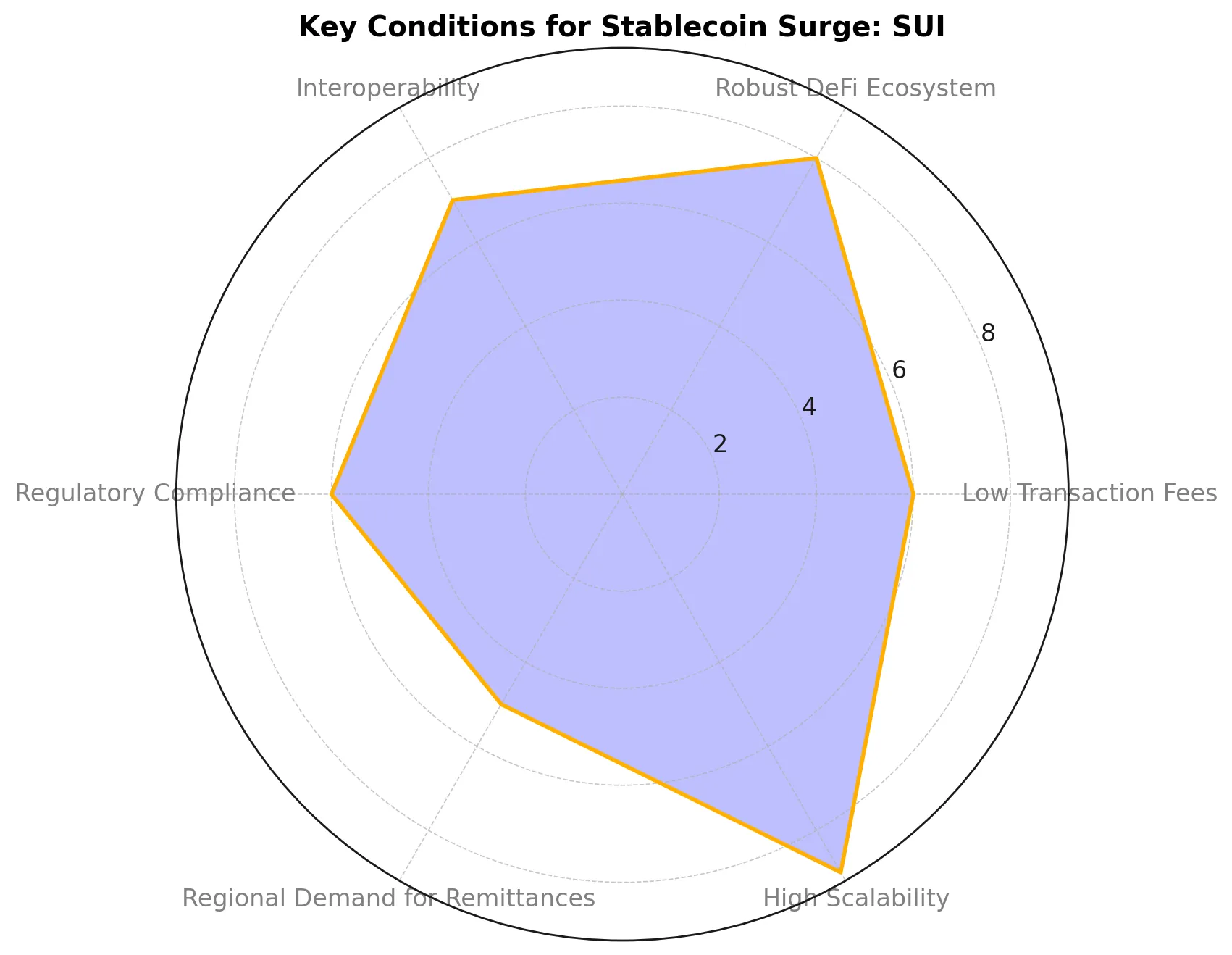
Key features driving stablecoin adoption
Advanced consensus protocols support high throughput and low latency: Sui uses the Narwhal and Tusk consensus protocols to support high transaction speeds and low latency. This design provides the ability for high transactions per second (TPS), making Sui an ideal platform for DeFi applications such as lending, borrowing, or complex trading scenarios that require high transaction speeds and reliability. Low latency also benefits stablecoin users who require instant settlement.
Case Use Case: High-frequency trading is an important part of DeFi, and stablecoins are crucial in fast collateral swaps and liquidity provision. Sui’s high throughput may attract institutional-grade DeFi protocols that rely on stablecoins, thereby becoming a competitor to Ethereum in high-value DeFi transactions.
DeFi-centric ecosystem attracts institutional users: Sui is actively positioning itself as a DeFi-focused blockchain, with early applications focused on lending, decentralized exchanges (DEX), and asset management. As stablecoins are critical to DeFi applications, Sui's focus on building a strong DeFi foundation may drive demand for stablecoins as collateral, liquidity pools, or medium of exchange.
Institutional interest: Sui’s programmable infrastructure allows for customized compliance solutions, which could appeal to institutions seeking a secure, compliance-friendly environment for stablecoin trading. This capability could lead to collaborations with regulated stablecoin issuers, enhance credibility and attract institutional interest.
Security and flexibility based on the Move programming language: Sui uses the Move programming language designed for security and asset protection. Move's resource-oriented programming model minimizes the risk of errors and ensures a secure trading environment, which is attractive to both retail and institutional users. The enhanced security may make Sui a safe environment for high-value stablecoin transactions and complex DeFi protocols.
If Sui can capture 0.5-1% of the Ethereum stablecoin-driven DeFi market (valued at approximately $40 billion), it will bring an additional $200 million to $400 million in stablecoin market value growth to the Sui ecosystem. Given Sui's current market value of $800 million, this surge in activity could increase its valuation to over $1 billion, doubling its market value. At the same time, Sui's architecture and compliance potential may attract institutional users who prioritize a stable and secure digital asset environment. If Sui becomes the preferred chain for institutional DeFi, it may see significant capital inflows, thereby establishing its core position in the DeFi field along with Ethereum and BSC.
Sui’s value proposition across use cases
The use of the Move programming language enhances the Sui ecosystem, providing a secure environment for developers to build robust financial applications. Move's resource-oriented programming model reduces the risk of errors and ensures the secure handling of digital assets in smart contracts. This makes Sui particularly attractive for institutional-grade stablecoin use cases that focus on security and compliance. For example, programmable stablecoins deployed on Sui can support highly secure loan and borrowing agreements, with collateral and repayments enforced by algorithmic rules. This feature may attract large financial institutions that want to integrate stablecoins into their operations.
For example, in November 2024, Sui entered into a strategic partnership with Franklin Templeton Digital Assets, the digital asset division of global investment firm Franklin Templeton. The partnership aims to support developers within the Sui ecosystem and deploy innovative technologies using the Sui blockchain protocol. Franklin Templeton’s involvement highlights Sui’s potential to drive institutional growth.
Sui’s compliance-focused infrastructure makes it a viable platform for cross-border trade, where stablecoins can be used to settle international transactions in real time and enforce trade terms through smart contracts. This institutional appeal and flexibility enables Sui to compete with Ethereum in high-value stablecoin use cases.
Disclaimer: This article is for general information purposes only and does not constitute investment advice, a recommendation, or a solicitation to buy or sell any security. The content of this article should not be relied upon in making any investment decision and should not be used as accounting, legal, tax advice, or investment recommendations. You are advised to consult your own advisors regarding legal, business, tax, or other matters relevant to any investment decision. Certain information contained in this article may have been obtained from third parties, including companies in which funds managed by Aquarius have investments. The opinions expressed in this article are those of the author alone and do not necessarily reflect the views of Aquarius or its affiliates. These opinions are subject to change at any time and are not guaranteed to be updated.
Reference
https://defillama.com/stablecoins
https://www.chainalysis.com/blog/stablecoins-most-popular-asset/



